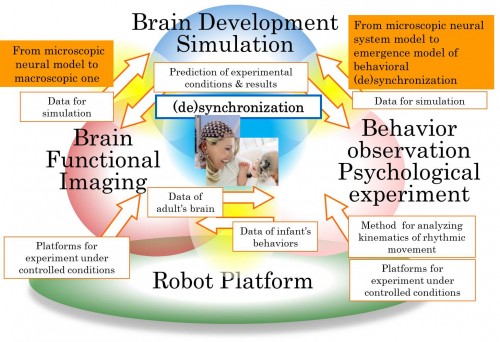When I saw this story, I was thinking strictly from an analytical standpoint. Then I watched the first video and that creepy feeling began to take hold as my imagination saw this thing being born to a new mother. As the doctor hands over the new infant, tell me she wouldn’t freak the freak out?
Leave it to the Japanese to come up with an android baby that acts eerily similar to a real baby, but in a horror movie kind of way.
Baby Affetto first appeared last year, but this is his debut here at GT. It’s all part of a neuroscience program at Osaka University. Affetto (the baby robot) was designed to test how cognitive functions develop. The creepy part is just an added bonus.
In the first video, we see a facial motion test and as we watch, we realize it’s a baby head moving on a table top! I fainted when I saw it! OK, I didn’t faint, but it could happen!
Actually, Its face was made as realistic as possible so it’s human attendants would think if it as a live baby instead of the nightmare robot that it is. Yea, I can almost see where….No! No! Get that thing away from me!
Here’s the scoop straight from the study:
Constructive Developmental Science based on understanding the process from neuro-dynamics to social interaction
Purpose and Background of the Research
How the microscopic neural activity is reflected in the human behaviors is a big mystery shared by many different disciplines. Medical and neuro- science have tried to explain the microscopic structure inside a brain but have not much focused on the macroscopic structure of social interaction. Contrarily, cognitive science and developmental psychology mainly observe human behaviors and therefore it is difficult to understand the internal mechanism.
We have been advocating Cognitive Developmental Robotics (CDR) which aims to provide new understanding how human’s higher cognitive functions develop by means of synthetic approaches that developmentally construct cognitive functions.
In this project, we focus on an issue of self/other cognition, based on CDR approaches: 1) a large scale simulation of brain development with realistic body, 2) imaging studies for real-time interaction, 3) building a realistic child robot with muscle-skeleton system, 4) behavioral experiments with robot platforms, and then, 5) establishment of constructive developmental science.
Research Methods
(1) Simulation group constructs a brain neuro-dynamics model which can exhibit the brain waves and tunes it to compare the activity to the real one, which is observed by MEG or fMRI. (2) Imaging group observes brain activities in real-time interaction comparing with the simulation results. Mirror neuron system is one of the main targets to understand the brain mechanism related to the development of self/other concept. (3) Robot group builds infant robots which are connected to artificial brain and can interact with a human. (4) Psychological group observes and analyses infant behaviors such as rhythmic movement and social interactions related to synchronization or de-synchronization.
Expected Research Achievements and Scientific Significance
First, we may make an impact on neuroscience by suggesting a neural network related to the development of the self-other concept. We may make another impact on cognitive science and developmental psychology by providing simulations or psychological experiments with a robot that have a computational model of the development of the self-other concept. As a matter of fact, also this makes a big impact upon the design theory of robots which are expected into our human society. The mutual feedback with these disciplines is indispensable to improve our model, and the strong connection with them will enable the establishment of a new science, “constructive developmental science” that has a stronger impact on current science and technology.
As if that first video wasn’t enough to keep us awake at night waiting for Baby Affetto to strangle us in our sleep, here’s one with full torso action!
Affetto has no less than 22 pneumatic actuators to simulate human response. It’s really quite amazing if you can get past the whole Affetto the killer cyborg baby thing.
All joking and intense willies aside, I can see where this study could be very beneficial in the study of how we function and develop.
Lets just hope Baby Affetto never escapes from the lab. I can see it now:
Godzilla VS Baby Affetto
Godzilla Gets Goo Goo’d
“A Stroller Coaster from beginning to end” Says Vic Hugo of the SF Bay News & Grill.
Fred Clutch of the NY Sentinel Dog & Pony Show exclaims, “Affetto is the creepy action hero of the summer!”
Killer Babies from the Midwest Magazine rates this movie “4-1/2 loaded diapers”.
Thanks to me for scouring Youtube yesterday, but mostly I want to thank The Asada Lab at Osaka U for bringing Baby Affetto to life.
You can contact the program here: [email protected]
Associated Content:
GT: Videos: Robot Apocalypse Not Far Off
GT: Friday Video: That’s Impossible – Real Terminators
EX: Android World






